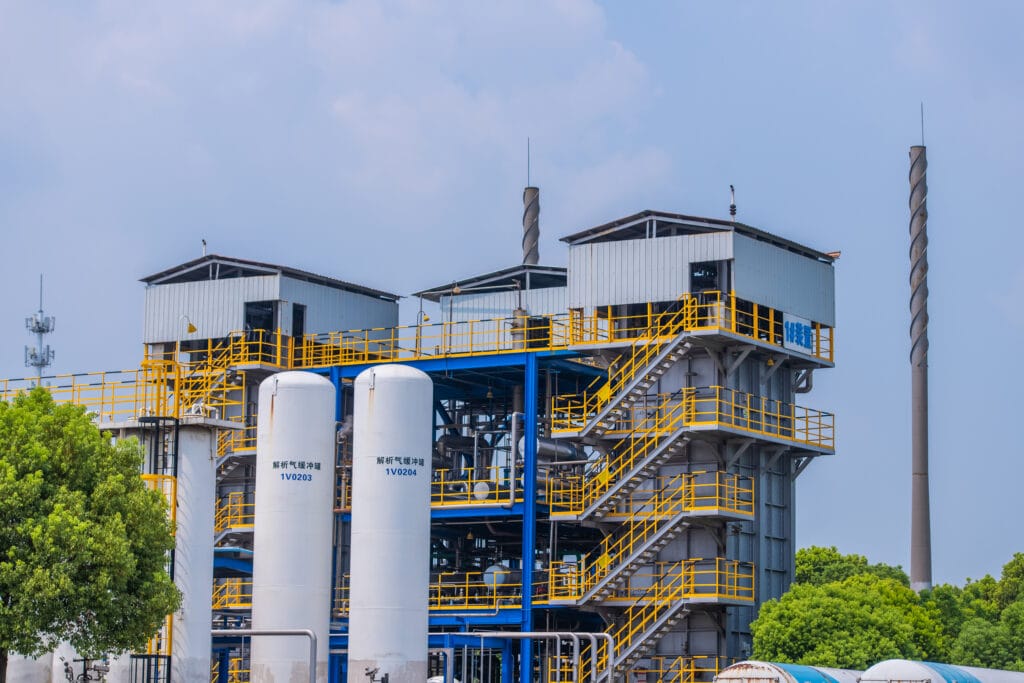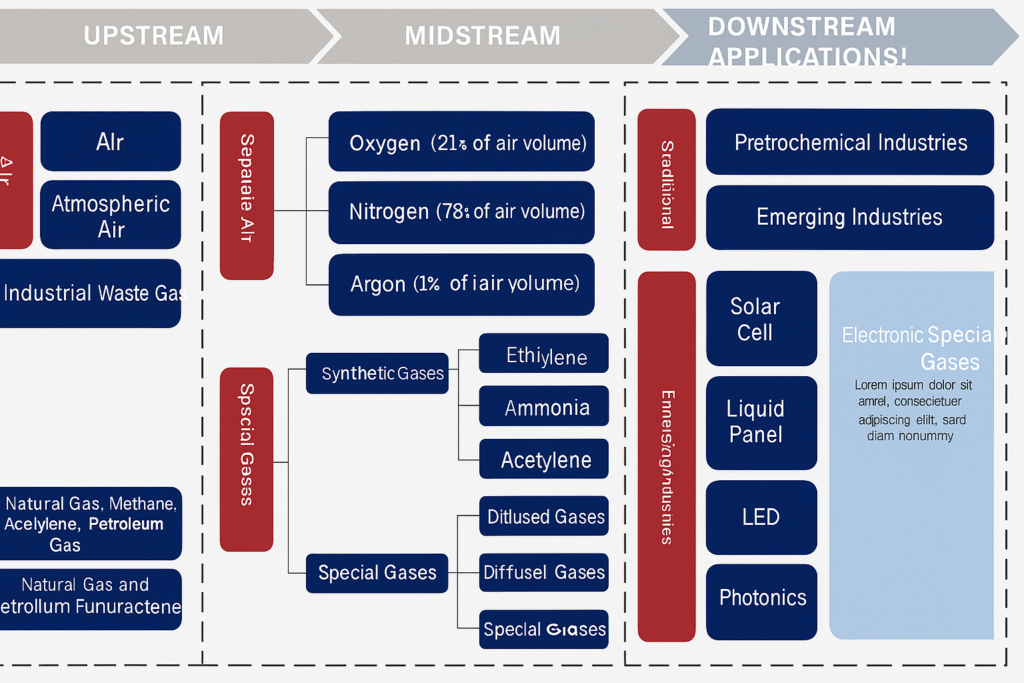1. What Are Industrial Gases?
Industrial gases are often referred to as the “lifeblood of industry.” Depending on the application, industrial gases can be classified into two major categories: bulk gases and specialty gases.

1.1 Bulk Gases
These are industrial gases with purity requirements below 5N (99.999%) and typically feature high production and consumption volumes. Based on production methods, they are divided into air separation gases and synthetic gases.
- Air separation gases are extracted from atmospheric air and include oxygen, nitrogen, and argon. They are widely used across multiple downstream sectors in large quantities.
- Synthetic gases include ammonia, methane, and acetylene, which are produced through entirely different processes compared to air separation gases.
1.2 Specialty Gases
Specialty gases are used in specific fields and have stringent requirements regarding purity, composition, and physical/chemical properties. They can be further categorized into calibration gases, medical gases, laser gases, food-grade gases, lighting gases, and electronic specialty gases.
1.3 Downstream Applications of Industrial Gases
The upstream of the industrial gas value chain mainly involves air separation unit (ASU) manufacturers and raw chemical suppliers. Notably, energy costs make up a significant portion of the total production cost for industrial gases.
Key downstream industries include metallurgy, petrochemicals, welding, and metal processing.
- Bulk gases are primarily consumed in traditional industries like metallurgy and chemicals, where large volumes are needed but purity requirements are lower.
- Specialty gases are used in high-tech sectors such as semiconductors, biopharmaceuticals, food and beverage, and renewable energy. These applications require a broad variety of gases in small quantities, with extremely high purity standards.

Illustration: Application Areas of Bulk Gases
2. The Industrial Gas Value Chain
In China, the downstream market is dominated by traditional industries such as coal chemicals and steel. In contrast, overseas markets are more diversified.
Industrial gases serve a wide range of industries. Traditional sectors like coal chemicals, steel, fertilizers, and petrochemicals have relatively low technical barriers but high gas demand. In China, these sectors account for over 70% of total industrial gas consumption.
For example, at global gas leader Linde, downstream usage in chemicals, energy, and metallurgy accounts for only 34%, significantly lower than the domestic average. Linde has a higher share in non-traditional segments like healthcare (19%), food & beverage (10%), and electronics (8%). This suggests significant growth potential for Chinese gas companies in high value-added markets.
3. Applications of Specialty Industrial Gases
3.1 Semiconductor Manufacturing
Electronic specialty gases are essential support materials in IC (integrated circuit) manufacturing and are used in photolithography, etching, deposition, cleaning, doping, and other processes. These gases require exceptional purity, stability, and precise packaging. Often dubbed the “grain” and “lifeblood” of the semiconductor industry, hundreds of specialty gases are involved in thousands of processing steps.
They include:
- Doping gases
- Ion implantation gases
- Cleaning gases
- Etching gases
- Photolithography gases
3.2 Other Fields
- Display panel manufacturing involves cleaning, etching, and CVD-based thin film deposition using gases such as NF₃, SiH₄, PH₃, and ultra-pure NH₃.
- Photovoltaic cell production uses gases like POCl₃ and O₂ for diffusion and film deposition processes.
Illustration: Specialty Gas Categories by Application Field
4. Key Specialty Industrial Gases
Top 10 electronic specialty gases account for 56% of market share. The most common include NF₃ and WF₆.
| Specialty Gas | Common Applications |
|---|---|
| Silane (SiH₄) | Semiconductor manufacturing (deposition of silicon), solar cells |
| Ammonia (NH₃) | LED production, semiconductor cleaning, refrigeration systems |
| Nitrous Oxide (N₂O) | Oxidizing agent in semiconductor etching, medical anesthetic |
| Sulfur Hexafluoride (SF₆) | Insulation gas in high-voltage equipment, plasma etching in electronics |
| Hydrogen Chloride (HCl) | Semiconductor cleaning and etching, pharmaceutical synthesis |
| Carbon Tetrafluoride (CF₄) | Dry etching in microelectronics, refrigerant |
| Hexafluoroethane (C₂F₆) | Plasma etching in chip production, cleaning gas for CVD chambers |
| Phosphine (PH₃) | Doping agent in semiconductor fabrication |
| Boron Trichloride (BCl₃) | Plasma etching, doping in integrated circuits production |
4.1 Nitrogen Trifluoride (NF₃)
A stable, colorless, and odorless gas under room temperature, NF₃ is a powerful oxidizer. High-purity NF₃ offers superior etching rates and selectivity for silicon-based materials. It leaves no residue post-etching, making it ideal for cleaning plasma chambers and is widely used in semiconductors, flat panel displays, and amorphous silicon solar cells.
Production methods include electrolysis and chemical fluorination. Chinese manufacturers mainly use molten salt electrolysis, while Western producers favor chemical fluorination.
4.2 Tungsten Hexafluoride (WF₆)
The only stable tungsten fluoride, WF₆ is highly corrosive and exhibits dynamic physicochemical properties depending on its environment. It’s widely used as a CVD precursor for tungsten interconnects in ICs. These metal layers serve as highly conductive interconnects, vias, and diffusion barriers between silicon and aluminum. WF₆ is also used in solar absorbers and X-ray emitter electrodes.
Industrial production involves reacting tungsten powder with fluorine gas, followed by multi-step purification and distillation to achieve 99.999%+ purity. The semiconductor industry accounts for nearly 76% of global WF₆ consumption.
4.3 Hexafluorobutadiene (C₄F₆)
Used in advanced semiconductor etching processes, it outperforms traditional etching gases with higher speed, selectivity, and aspect ratio, while being more environmentally friendly.
Production technology is dominated by firms in Russia, Japan, and South Korea. Domestic capabilities are growing but still rely heavily on imports for high-end electronic-grade supply.
4.4 Hexafluoroethane (C₂F₆)
A stable, non-toxic perfluorocarbon that accounts for 50% of the global PFC market. It’s used as a refrigerant, etchant, cleaner, and in medical applications.
China largely relies on imports. Domestic leaders include Huate Gas and CSIC Gases. Some companies produce C₂F₆ primarily for refrigerant use, such as Huaan New Materials and Sanmei.
4.5 Sulfur Hexafluoride (SF₆)
A key fluorinated gas made by reacting fluorine with sulfur. Comes in industrial and electronic grades.
- Industrial grade is widely used in power transmission and control systems (GIS, breakers, transformers, etc.).
- Electronic grade is used in semiconductor and display etching and cleaning. Only a few domestic producers are capable of making this grade.
4.6 Octafluorocyclobutane (C₄F₈)
A green, non-toxic, ozone-friendly gas with low global warming potential. Used in high-voltage insulation, VLSI etching, mixed refrigerants (as a CFC substitute), aerosol propellants, and electronic-grade cleaning.
Typically produced via polymerization.
4.7 Octafluoropropane (C₃F₈)
A high-purity etching and cleaning gas in semiconductor manufacturing. With growing precision in chip fabrication, its demand and purity requirements (over 99.999%) are increasing rapidly.
4.8 Silane (SiH₄)
A compound of silicon and hydrogen, including monosilane (SiH₄), disilane (Si₂H₆), and higher silanes. Production methods include magnesium silicide reduction, disproportionation, and electrochemical methods.
China primarily uses the magnesium silicide route, while foreign producers favor electrochemical synthesis.
Used in semiconductors, photovoltaics, flat panel displays, and as coatings for glass and steel.
4.9 Silicon Tetrachloride (SiCl₄)
Available in industrial and high-purity grades. High-purity SiCl₄ is used in fiber optics, ICs, and aerogels.
- Semiconductor-grade (e.g., VAD, OVD, PCVD types) is used in preform fabrication for optical fibers.
- Electronic-grade SiCl₄ is an advanced electronic chemical mainly used for film deposition and etching, still heavily reliant on imports.
4.10 Phosphine (PH₃) and Arsine (AsH₃)
Both are critical semiconductor materials, particularly for CVD in IC and LED production.
Arsine is flammable, explosive, and highly toxic.
Phosphine is a key N-type dopant for polycrystalline silicon deposition, GaP epitaxy, ion implantation, MOCVD, and phosphosilicate glass passivation.
4.11 Photolithography Gases
These include rare gases such as helium, neon, argon, krypton, and xenon, used during the photolithography process, which directly impacts chip performance and yield.
They serve two functions:
- As the lasing medium in lithography machines, generating specific wavelengths to expose photoresist.
- In plasma etching, to remove unprotected photoresist layers and define circuit patterns.
Ukraine is a major supplier, providing 70% of global neon, 40% of krypton, and 30% of xenon. For ArF excimer lasers, neon makes up 96% of the Ar/F/Ne gas mix. Krypton is mainly used in photolithography, while xenon is used in etching.
If you require high-purity or specialty industrial gases for your operations, we offer reliable and tailored supply solutions across industries such as electronics, healthcare, environmental protection, and new energy. Feel free to contact us for customized gas solutions.



